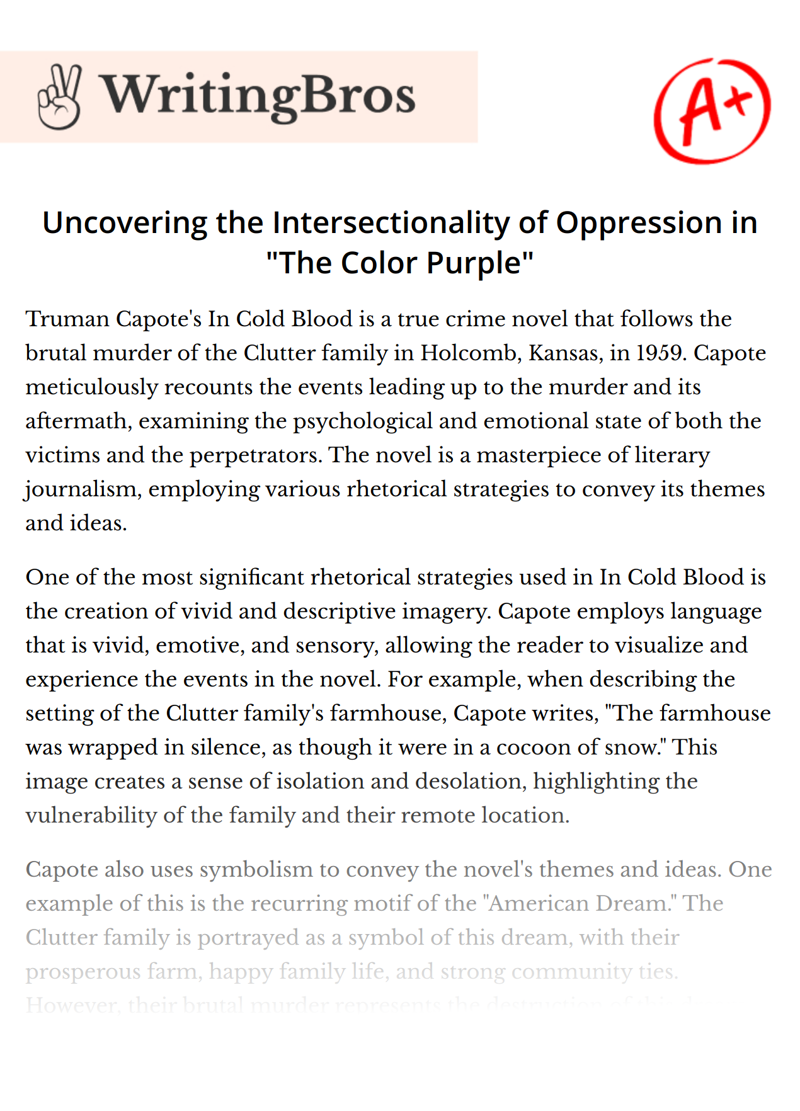Uncovering the Intersectionality of Oppression in "The Color Purple"
 Read Review
Read Review
 Read Review
Read Review

Truman Capote's In Cold Blood is a true crime novel that follows the brutal murder of the Clutter family in Holcomb, Kansas, in 1959. Capote meticulously recounts the events leading up to the murder and its aftermath, examining the psychological and emotional state of both the victims and the perpetrators. The novel is a masterpiece of literary journalism, employing various rhetorical strategies to convey its themes and ideas.
One of the most significant rhetorical strategies used in In Cold Blood is the creation of vivid and descriptive imagery. Capote employs language that is vivid, emotive, and sensory, allowing the reader to visualize and experience the events in the novel. For example, when describing the setting of the Clutter family's farmhouse, Capote writes, "The farmhouse was wrapped in silence, as though it were in a cocoon of snow." This image creates a sense of isolation and desolation, highlighting the vulnerability of the family and their remote location.
Capote also uses symbolism to convey the novel's themes and ideas. One example of this is the recurring motif of the "American Dream." The Clutter family is portrayed as a symbol of this dream, with their prosperous farm, happy family life, and strong community ties. However, their brutal murder represents the destruction of this dream, suggesting that the ideal of the American Dream is nothing more than a fragile illusion.
Another important rhetorical strategy employed in the novel is the use of irony. Capote often presents events and characters in a way that is at odds with reality, creating a sense of irony and highlighting the absurdity of the situation. For example, the killers, Perry Smith and Dick Hickock, are portrayed as charming and likable, even though they are responsible for the brutal murder of an innocent family. This ironic contrast underscores the moral ambiguity of the situation, challenging readers to confront their own prejudices and assumptions.
Capote's use of multiple perspectives is also a significant rhetorical strategy employed in the novel. By presenting the events from different points of view, Capote creates a complex and nuanced portrayal of the murder and its aftermath. The perspectives of the killers, the victims, and the investigators are all presented, allowing the reader to gain a deeper understanding of the motivations, fears, and desires of each character.
Finally, the structure of the novel itself is a crucial rhetorical strategy used by Capote. The novel is divided into four parts, each with a different focus and tone. The first part introduces the characters and the setting, creating a sense of suspense and foreboding. The second part details the murder itself, employing a detached and journalistic style that emphasizes the brutality of the crime. The third part focuses on the investigation and trial, highlighting the legal and ethical issues surrounding the case. Finally, the fourth part concludes with a reflection on the aftermath of the murder, emphasizing the lasting impact on the community and the individuals involved.
In conclusion, Truman Capote's In Cold Blood is a masterful work of literary journalism that employs various rhetorical strategies to convey its themes and ideas. Capote's use of vivid imagery, symbolism, irony, multiple perspectives, and narrative structure creates a complex and nuanced portrayal of the murder and its aftermath. The novel challenges readers to confront their own assumptions and prejudices, highlighting the fragility of the American Dream and the destructive power of violence. It is a novel that continues to captivate and disturb readers, reminding us of the enduring power of literature to explore the darkest corners of the human psyche.
Cite this Essay
To export a reference to this article please select a referencing style below




